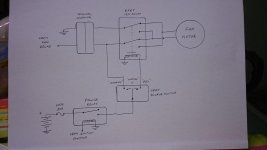This post is intended to give more insight into my system for reversing the fan....
First, some facts that I have found out... the cooling fan does not turn on when you are riding at medium to high speed, it is quite obvious, the air flowing past the radiator is enough to cool it down... I have confirmed it by looking at the fan several times at such speed, thankfully without getting my head knock off by opposing vehicles!.... I have also experienced the hot right foot issue when I got stuck in a traffic jam, completely no forward movement for about 15 to 20 minutes!...I then observed or feel rather, that the air coming out the right side is hotter than normal, this I attribute it to the hot exhaust from vehicles in front being drawn into my radiator when the cooling fan turns on, adding to the heat from the radiator, and since the Spyder is stationary, the heat just builds up around the right side....things get slightly better (less hot) when the jam starts moving, though at a slow pace but it is still hot nonetheless... after that to the drawing board...and I designed my system with the following 3 modes of operation controlled by the rocker switch mounted on the top panel:
1) Normal operation, fan rotates normally, pulls air to the rear, on and off controlled by coolant temperature. Used for normal highway cruising.
2) Reverse operation, fan rotates reverse direction, pushes air to the front, on and off controlled by coolant temperature. Used when stuck in a jam or at very slow speed. Even if you forget to switch back to normal mode, the fan will not turn on when the traffic clears and higher speed is attained (see above).
3) Override operation, fan rotates normally, pulls air to the rear, fan remains on regardless of coolant temperature. This mode is used when traffic is heavy and moving not fast enough for sufficient air to enter the radiator. Useful for lowering the coolant temperature during stop lights, idling etc...
With the modes as explained above, I don't think I need to consider using the wheel speed sensor to trigger the fan on or off.... it only adds to the complexity and more electronic items to fail...
I will post a schematic wiring diagram when it is ready and also some photos of the installation...
Also, my experience with this set up so far.... I have done some stationary idling test with the reverse fan operation and normal fan operation and I have noted that the fan takes longer time to switch off when it is in reverse mode, meaning the coolant temperature takes a longer time to reduce to the point whereby it triggers the fan off ... this is probably due to the less efficient way of pushing air through the radiator than pulling it.... maybe that's why BRP using two radiators in the 2014s....
Well, so much for now.... will report back when more kilometres (miles) is piled on...

